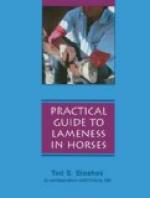In veterinary literature there is occasionally described a condition which affects young foals wherein symptoms similar to those of contraction of the flexors are manifested, but upon examination it is found that rupture of the extensor of the digit (extensor pedis) exists. This affection is briefly described by Cadiot but no complete treatise on this condition has been published.
In parts of Canada foals of from one to three days of age are found affected in such manner that more or less interference with the gait is to be seen in those moderately affected. There is, in some subjects, only a slight impediment in locomotion which is occasioned by inability to properly extend the digit. In other subjects, while able to stand and walk, great difficulty is experienced because of volar flexion of the phalanges. The more seriously affected animals are unable to stand and, in most instances, perish because of the effects of prolonged decubitus.
A local enlargement occurs at the anterior carpal region and the mass is somewhat fluctuating, extravasated fluids becoming infected in many instances, and necrosis of the skin and fascia provide means for spontaneous discharge of the contents of the enlargement if it is not opened. The infection when it becomes generalized causes a fatal termination in most cases that are not treated.
[Illustration: Fig. 25—“Fish knees.”—Photo by Thos. Millar, M.R.C.V.S.]
Native stock owners of some parts of Canada know this condition as “fish knees” because of the presence of the ruptured end of the extensor tendon which is found coiled in the cavity of the enlargements caused by the ruptured tendon.
Local practitioners have treated the condition by incising the swollen mass and removing the part of tendon contained within such cavities. Treatment has not proved entirely satisfactory in the majority of instances, perhaps because of tardy interference.
In a colt’s leg sent the author by Mr. Thomas Millar, M.R.C.V.S., of Asquith, Saskatchewan, a careful dissection of the carpal region revealed the fact that in this case the ruptured extensor tendon was due to injury. The colt may have been trampled upon by its dam in such manner that the tendon was divided. No noticeable evidence of injury to the skin was to be seen on its outer surface, but on the fascial side a cyanotic congested area, which was situated immediately over the site of the ruptured tendon, was very evident.
With the execution of a good surgical technic, the ruptured tendon might be sutured; the wound of the tendon sheath as well as that of the skin carefully united by means of gut sutures, the leg bandaged and immobilized with leather splints and recovery follow in a reasonable percentage of cases so treated. These cases afford an opportunity for the perfection of practical means of treatment by those who frequently meet with this affection.
Rupture of the Flexor Tendons and Suspensory Ligament.




